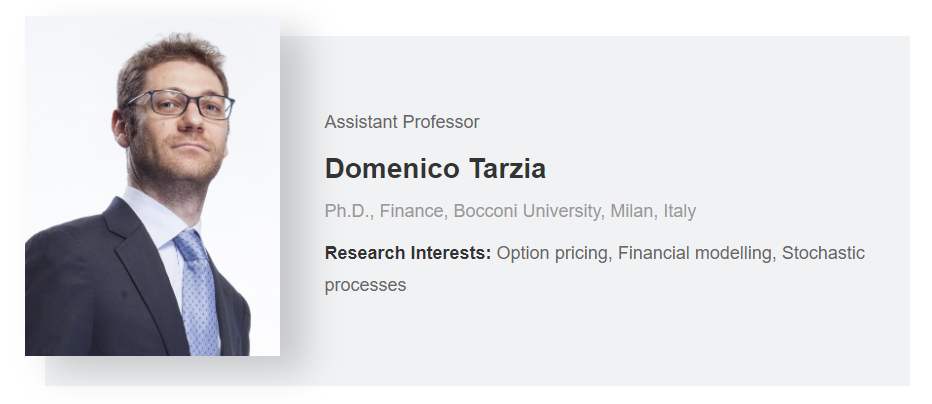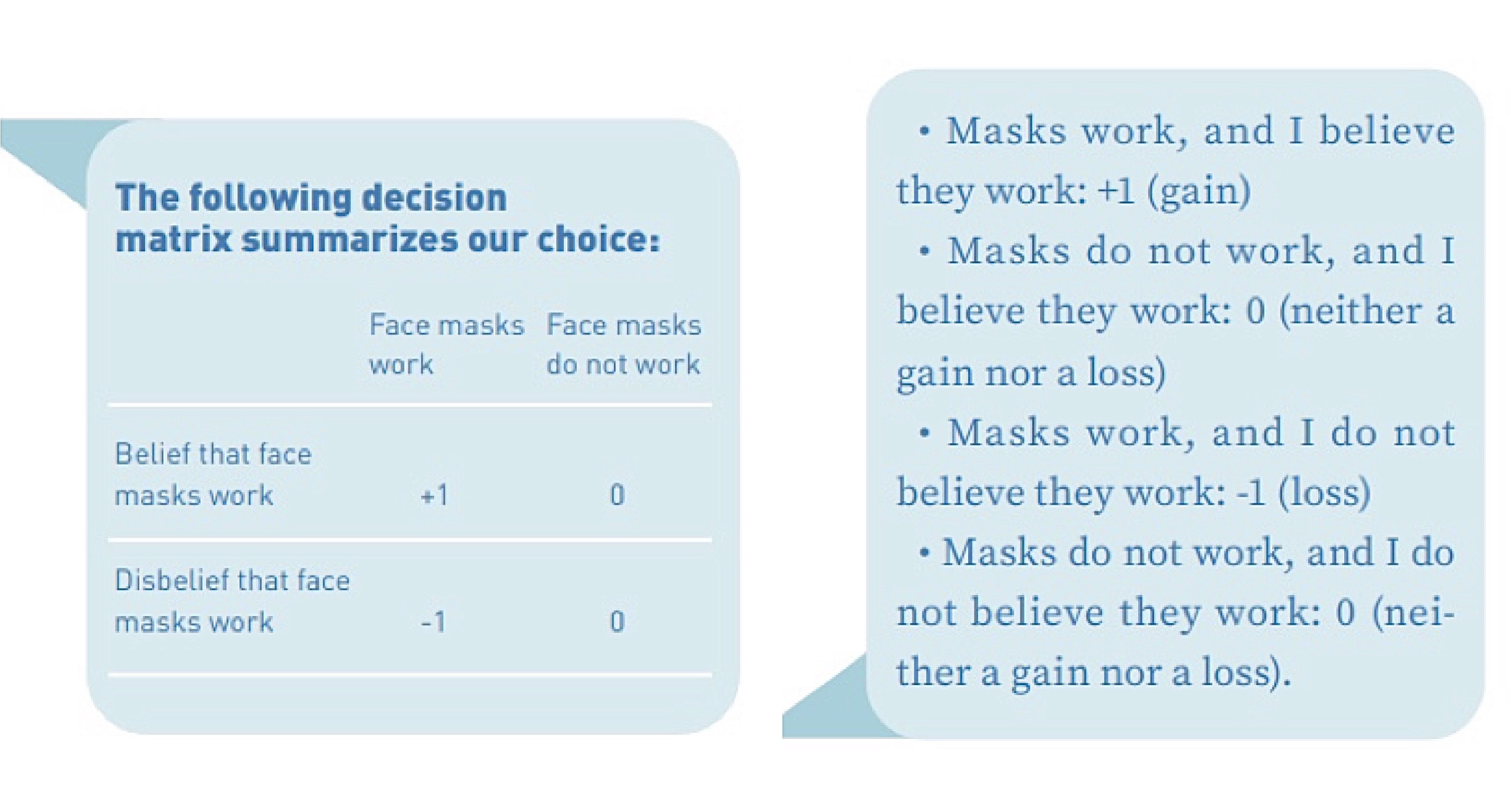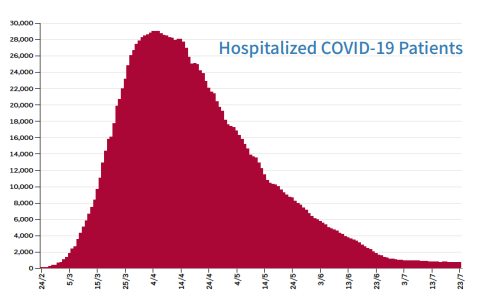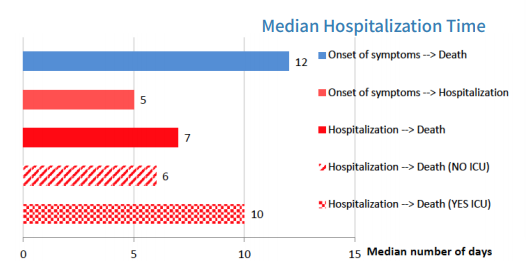Despite evidence that face masks combined with other preventive measures, such as frequent hand-washing and social distancing, help slow the spread of COVID-19, there was debate in many countries about wearing a mask. Naturally, people posed questions like, “Do I need to wear a face mask if I do not feel sick?”
Face masks can prevent larger exhaled moisture drop - lets from evaporating into smaller ones that can travel farther. According to health experts, there is clear evidence that masks can help prevent the spread of COVID-19 and the more people wearing masks, the better. So, should you wear a mask if you do not feel sick?
Some may say, “You are talking about the same health experts and organizations saying masks were not that effective at the beginning of the pandemic. Why should I believe them now?” Given that, let us forget about health experts’ advice and frame our choice as a decision under uncertainty with the following outcomes:
How would you act as a rational decision maker? Still confused about wearing face masks?
“That is too theoretical; you have assigned arbitrary values to the possible states of the world. Moreover, I heard face masks might have side effects. I would like you to provide some empirical evidence,” some might argue.
Bearing that in mind, let us analyze the evolution of the COVID-19 pandemic in Italy, the first country in Europe to be battered by the virus. On February 21, the first domestic case of COVID-19 was confirmed in Italy. Clusters in northern Italy immediately emerged, and within a few days the disease spread to the entire country. In a matter of weeks (from February 21 to March 22), Italy went from the discovery of the first COVID-19 case to issuing a government decree that essentially prohibited all movement within the whole territory, as well as the closure of all non-essential business activities. Moreover, on April 6, Lombardy, the region most affected by the coronavirus, mandated wearing a face mask in public. Soon, other regions in Italy made mask use compulsory. How successful were the measures implemented to contain the spread of COVID-19?
In March, the number of confirmed, new daily cases in Italy peaked at about 6,500. Initially, the country's health - care system was strained, so, in general, only patients with the most severe cases were admitted to hospital. After a few weeks into lockdown, social distancing and compulsory face masks, the country started to experience a steady decline in daily new cases. Over 30 days (from July 26), the number of confirmed new cases fell to 5,661, much lower than the daily peak in March. Moreover, the country reported declines in active cases, use of the intensive care unit (ICU), hospitalized COVID-19 patients, and deaths as shown in the following graphs. The graph shows the evolution of active cases, i.e., infected people, from February 21 to July 23. Active cases peaked at 108,257 on April 19. As of July 26, there were 12,565 infected people. The effectiveness of the protective measures is evident by looking at COVID-19 hospitalizations depicted below.
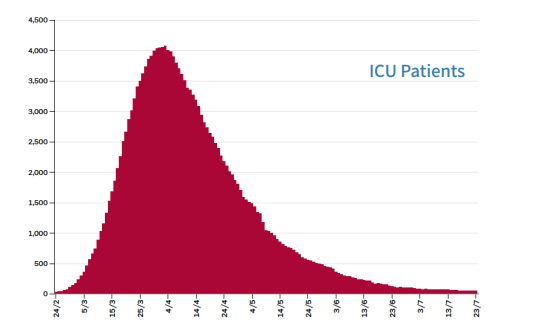
The figure above indicates patients in the intensive care unit (ICU) trend from February 21 to July 23. The number peaked at 4,068 on April 3. As of July 28, there were 44 ICU patients with COVID-19.
The graph above indicates the trend of hospitalized patients. The number peaked at 29,010 on April 4. As of July 26, the number of hospitalized patients with COVID-19 was 735.
Protective measures have also heavily affected the distribution of COVID-19 patients. By July 26, the majority of patients were at home, experiencing mild symptoms (more than 99%). Moreover, the swab tests performed over the last period show an infinitesimal viral load in quantitative terms compared to the tests during previous months. Further, with the stressed health system finding some relief, medical workers on the frontlines reported fewer cases of patients with severe illness. The number of deaths also dropped significantly, with daily deaths peaking at 969 on March 27. On July 26, the daily death toll was five. Over the last 30 days, the number of deaths confirmed has been 240 people, much lower than the daily peak in March.
When comparing the evolution of new cases with deaths and assessing the usefulness of face masks and social distancing, the timeline should be taken into consideration. The figure below depicts the median hospitalization time on July 22, 2020.
The figure above shows the median number of days from onset of symptoms to one of the following outcomes: death, hospitalization or ICU. Taking into account the incubation period, it takes two to three weeks after infection for a severely infected person to reach critical condition or to die, so death curves generally follow one to two weeks behind infection curves.
On May 4, the Italian government eased restrictions, allowing the re-opening of manufacturing industries and construction sites, given the supporting evidence of the health care infrastructure no longer being overwhelmed. Shops, cultural sites, bars and restaurants, and hair salons were opened. However, all over Italy, masks must be worn in indoor public spaces and on public transport. It is not mandatory outdoors except in the event that a safe distance cannot be kept.
Now, please compare the evolution of the pandemic in Italy with nations that debated the prevention effectiveness of face masks, and ask yourself, “Do I need to wear a face mask if I do not feel sick?” Personally, I do!
Written in July 28
By Domenico Tarzia
